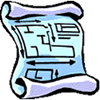

Choose
the best answer to each question and write the appropriate letter in
the space below.
A) In the thin handle
B)
Exactly
halfway along the bat
C) In the more massive end of the bat
A) a regular straight-line path.
B) a straight-line
path with irregular speed.
C) a wobbly path with irregular
speed.
A) drawing lines straight down from
suspension points.
B) looking at the intersection of
lines drawn from suspension points.
C) balancing it above your finger.
D) all of the above will work
B) Cookie
C) Pineapple
D) Donut
E) Apple
A) too high.
B) too low.
C) not over its area of support.
D) outside the object.
A) To look good
B) To be ready to grab something in case you fall
C) To change the mass of your body
D) To change the weight of your body and the load
E) To change the center of gravity of your body and
the load
A) raise its center of gravity.
B) lower its center of gravity.
C) neither raise nor lower its center
of gravity.
D) increase its mass.
E) decrease its mass.
A) raise its center of gravity.
B) lower its center of gravity.
C) neither raise nor lower its center
of gravity.
D) increase its mass.
E) decrease its mass.
A) raise its center of gravity.
B) lower its center of gravity.
C) neither raise nor lower its center
of gravity.
D) increase its mass.
E) decrease its mass.
A) your center of gravity is outside
your support area.
B) your center of gravity is not
located directly above your support area.
C) both A and B
11) The center of mass of the
solar system __________.
A) is at the center of the sun.
B) varies as the planets move.
C) neither A nor B
A) weight.
B) momentum.
C) inertia.
D) center of gravity.
E) none of the above
A) that is fixed, though different for different people.
B) that is always directly behind the belly button.
C) that changes as a person bends
over.
D) none of the above
A) midpoint.
B) edge.
C) center of gravity.
D) geometric center.
E) none of the above
A) half the mass of the wood will
be on either side of the line.
B) half the weight will be on
either side of the line.
C) the line will pass through
the center of gravity of the wood.
D) all of the above
E) none of the above
A) Stable
B) Unstable
C) Neutral
17) A ball resting on the floor
is in what kind of equilibrium?
A) Stable
B) Unstable
C) Neutral
18) A picture hangs on a wall
by a wire that is passed over a supporting nail. The picture is in stable
equilibrium because __________.
A) any slight push will raise
its center of gravity.
B) after any small push, it will
return to its original position.
C) its center of gravity is directly
below the supporting nail.
D) all of the above
A) a very broad root system.
B) very deep roots.
C) exceptionally strong roots.
A) rises.
B) falls.
C) neither rises nor falls.
24) When an object is balanced
so that a displacement lowers its center of gravity, the object is said
to be in stable equilibrium.
30) In terms of center of gravity,
discuss what determines whether or not an object will fall over when
tilted. Give examples.